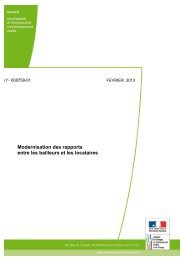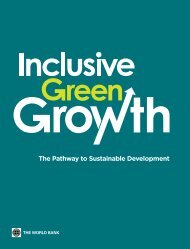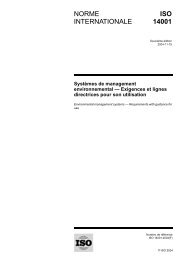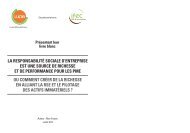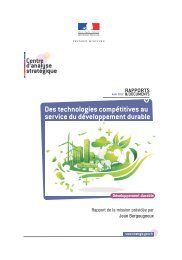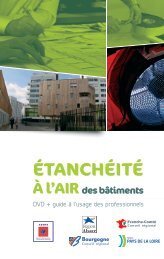in timber harvesting, manufacturing and consumption.There is already evidence <strong>of</strong> considerable progress inwood product industries. Examples include:• use <strong>of</strong> small-scale equipment and low-impact practicesin logging operations;• wood-saving manufacturing equipment (thin blades)and technologies (laser guides), and completeutilization <strong>of</strong> wood raw materials, including through <strong>the</strong>use <strong>of</strong> waste to generate heat and power;• product developments that utilize smaller, lower-qualitytrees while improving <strong>the</strong> performance <strong>of</strong> engineeredwood products, such as laminated beams and flooring;• use <strong>of</strong> recovered and recycled paper, paperboard and wood.Wood product manufacturers face many challenges,including changes in consumer preferences and globaldemographics, competition for resources, competingmaterials, and changes in <strong>the</strong> ownership <strong>of</strong> <strong>the</strong> foreststhat provide raw material. Forest industries typicallyrequire large capital investments and it is difficult for<strong>the</strong>m to adjust rapidly to changing economic conditions.Never<strong>the</strong>less, <strong>the</strong> overall outlook for <strong>the</strong> forest industryis generally good. Production and consumptionare expected to grow, while new investment andproduction are expected to continue shifting towards<strong>the</strong> more rapidly growing emerging economies.In developed country markets, wood products will benefitfrom a greater focus on meeting high environmentalperformance standards, and new wood-based productssuch as bioenergy, biochemicals and biomaterials will bea basis for overall industry growth (FAO, 2011c).Innovations in forest productsThe rate <strong>of</strong> innovation in global telecommunicationsis widely known. However, too few people are awarethat manufactured forest products are also undergoinga transformation, which is leading <strong>the</strong> transition <strong>of</strong> <strong>the</strong>forest sector in <strong>the</strong> green economy (Tissari, Nilssonand Oinonen, in press). Innovations in forest productstend to fall into two broad groups: subtle, evolutionaryinnovations involving gradual changes to processesthat are well established; and abrupt, revolutionaryinnovations creating new products and processes thathave never been seen before, such as using wood in <strong>the</strong>manufacture <strong>of</strong> electronics.Composite or “engineered” wood products are changingrapidly. Among <strong>the</strong> engineered wood products that aresubstitutes for solid wood are glulam beams, laminatedveneer lumber, parallel strand lumber, I-beams withoriented strand-board webs, and edge-glued, solid woodpanels. One <strong>of</strong> <strong>the</strong> most recent innovations, crosslaminatedtimber, is producing wood products withsuperior strength and dimensional stability, enabling <strong>the</strong>development <strong>of</strong> new construction techniques forhigh-rise buildings.Production technology in <strong>the</strong> plywood sector is alsochanging rapidly – especially in Asia – enabling <strong>the</strong>use <strong>of</strong> smaller logs, including from planted forests.New manufacturing processes are faster, more fullyautomated and capable <strong>of</strong> greater quality control.Innovations include laminated veneer board andlong-stick board. The most recent type <strong>of</strong> plywoodcontains a flexible core layer, creating a wood-basedpanel that can easily be bent into a variety <strong>of</strong> shapes andused in new processes and products.■■Wood technology laboratory. Innovations in forestproducts fall into two broad groups: subtle, evolutionaryinnovations involving gradual changes to wellestablishedprocesses; and abrupt, revolutionaryinnovations creating new products and processesIndonesia, <strong>the</strong> world’s largest exporter <strong>of</strong> hardwoodplywood, has invested in improved processing thatadds value to end products, for example by using directcoating to produce “colour-tone plywood” and mouldedor curved plywood products. Plywood is also being usedfor large-scale structures such as tank supports on <strong>the</strong>large commercial vessels that transport liquefiednatural gas.Many advances are being made in reconstituted panels,especially oriented strand board in North America andmedium-density fibreboard in Europe. Improvementsinclude increased strength, a wider range <strong>of</strong> densities,improved packaging, and greater product diversificationthrough a larger variety <strong>of</strong> surface treatments.FAO/R. Faidutti/CFU00021534 | Chapter 3
One <strong>of</strong> <strong>the</strong> more interesting technological developmentsis <strong>the</strong> increased manufacture <strong>of</strong> products that mix woodfibres with o<strong>the</strong>r materials, including flax, cotton, straw,paper and plastics, to produce wood composite boards.Wood–polymer composites are beginning to penetratemarkets owing to <strong>the</strong>ir ease <strong>of</strong> use and durability.Research in this area focuses on using wood resourcesmore efficiently, optimizing <strong>the</strong> physical properties <strong>of</strong> rawmaterials, making products with special properties such asresistance to fire or fungi, reducing manufacturing costs,and recovering waste when products are no longer useful.Technology and core products in sawmilling are notchanging as rapidly as <strong>the</strong>y are in composite products.The most important transition is that more timber comesfrom planted forests, and a higher percentage <strong>of</strong> logsare small by traditional standards. There have beenimprovements in log sorting, sawing yields, <strong>the</strong> speed<strong>of</strong> processing, <strong>the</strong> speed and quality <strong>of</strong> drying, andsurface treatment and non-toxic preservation. Many <strong>of</strong><strong>the</strong> natural defects <strong>of</strong> sawnwood can be removed bymeans <strong>of</strong> optical scanners, automated <strong>of</strong>f-cutting andfinger-jointing. Relatively new “hew-saw” technology iswell suited to <strong>the</strong> rapid processing <strong>of</strong> small logs into bulkgrades <strong>of</strong> lumber, simultaneously hewing slabs into chipsthat are suited for pulp.Forest industries are also at <strong>the</strong> forefront <strong>of</strong> innovationin <strong>the</strong> use <strong>of</strong> renewable sources <strong>of</strong> energy. Combinedheat and power units are <strong>the</strong> norm at forest productmanufacturing sites in Europe and North America, andare becoming more common in developing countries.Pulp and paper plants derive most <strong>of</strong> <strong>the</strong>ir energy fromwood bark and <strong>the</strong> black liquor that is produced in <strong>the</strong>pulping process. Energy consumption per unit <strong>of</strong> outputis declining throughout <strong>the</strong> pulp and paper industry.Non-wood forest productsAs well as being a source <strong>of</strong> essential food, NWFPsare also an economic foundation for millions <strong>of</strong> families(CIFOR, 2012). Worldwide, <strong>the</strong> estimated value <strong>of</strong> NWFPremovals in 2005 was USD 18.5 billion (FAO, 2010c), butthis estimate is conservative because NWFPs are rarelyreflected in <strong>of</strong>ficial national economic statistics. NWFPsare an important complement to agricultural income,and <strong>the</strong>y serve as safety nets during calamitiessuch as drought and civil unrest (Scherr, White andKaimowitz, 2004).<strong>Forests</strong> and trees on farms represent a vital source <strong>of</strong>food for many <strong>of</strong> <strong>the</strong> world’s poorest people, providingboth staple foods and supplemental foods such as fruits,edible leaves and nuts; fodder and browse for livestock;and fuel for cooking and food processing. It is <strong>of</strong>ten<strong>the</strong> poorest people who depend <strong>the</strong> most on forests.Households living on <strong>the</strong> margins <strong>of</strong> poverty are exposedto food insecurity at certain times <strong>of</strong> <strong>the</strong> year, whenincome levels drop. This may be during <strong>the</strong> lean season(when crops are still growing in <strong>the</strong> fields and stocks from<strong>the</strong> previous harvest are exhausted) or in times <strong>of</strong> famineor food shortage. Forest foods are particularly importantduring <strong>the</strong>se periods. Plants and animals found in forestsprovide a critical source <strong>of</strong> protein and important vitaminandnutrient-rich supplements for rural households,adding variety to diets and improving <strong>the</strong> taste andpalatability <strong>of</strong> staples. NWFPs <strong>of</strong>ten form a small butcritical part <strong>of</strong> o<strong>the</strong>rwise bland and nutritionally poor diets(FAO, 2011a).There are significant challenges to <strong>the</strong> continued use <strong>of</strong>NWFPs as a source <strong>of</strong> rural income and employment.Most <strong>of</strong> <strong>the</strong> livelihoods supported by NWFPs arecharacterized by low productivity, inadequateprocessing and value addition, and poorly integratedmarkets. NWFPs’ potential value to local people ishindered by factors such as <strong>the</strong> remoteness <strong>of</strong> forests,poor infrastructure, unclear tenure rights, and limitedaccess to financial and market services. Low returnsand unfavourable market conditions <strong>of</strong>ten lead tounsustainable exploitation <strong>of</strong> NWFPs. To enhance <strong>the</strong>many benefits that NWFPs provide, <strong>the</strong>re is need toraise awareness <strong>of</strong> <strong>the</strong> contributions that forests andtrees make to nutrition and food security strategiesand policies; increase support for adequate and locallycontrolled forest management and use; give greaterattention to pro-poor forestry measures; and support<strong>the</strong> development <strong>of</strong> economically, socially andenvironmentally sustainable small and mediumforest enterprises.Investing in NWFPs provides an opportunity to streng<strong>the</strong>n<strong>the</strong> livelihoods <strong>of</strong> forest-dependent people, contribute to<strong>the</strong>ir nutrition and food security, and help conserve <strong>the</strong>irresource base. Enhancing <strong>the</strong> entrepreneurial capacities<strong>of</strong> people engaged in NWFP collection would result inincreased income and provide an incentive for betterforest protection and management. Areas for investmentinclude improving technical knowledge and informationon sustainable harvesting, collection, storage, processingand value addition; overcoming <strong>the</strong> isolation <strong>of</strong> smalland medium forest enterprises by connecting <strong>the</strong>m toeach o<strong>the</strong>r and to markets, service providers and<strong>Forests</strong>, forestry and forest products for a sustainable future | 35




